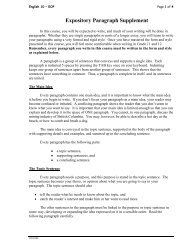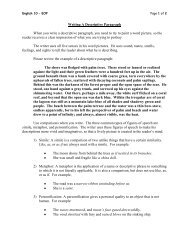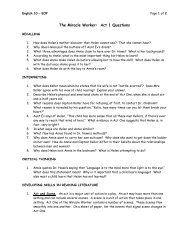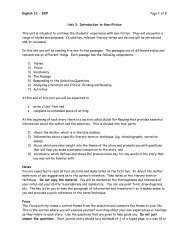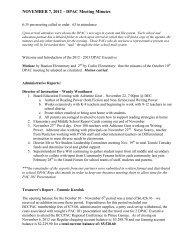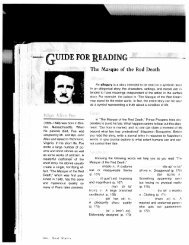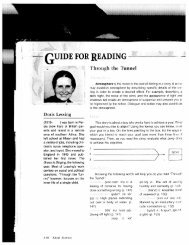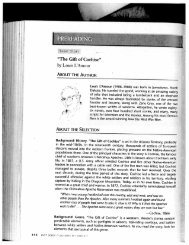Create successful ePaper yourself
Turn your PDF publications into a flip-book with our unique Google optimized e-Paper software.
I I\G ) 1111 Si ii ( I P)\<br />
1 ,uld ask Grandfather a question about<br />
.orj what would you ask? Why?<br />
2 .,r ild tell a future generation a story from<br />
yo ir )uth, what would it be? Explain.<br />
3, H v did Grandfather learn the story of his fam<br />
s s ape from Alcatraz—an event that took<br />
p ace en he was a small boy?<br />
4, Accord ng to the story, what does the “dia<br />
mond of Diamond Island represent?<br />
5, lrterpret the narrator’s comment on page 98,<br />
Tht episode, that sailing and that recording<br />
was only a moment ago” What does the com<br />
ment uqqest about the history of Alcatraz<br />
island?<br />
6. Why did Grandfather ask the narrator to visit?<br />
7, In your words, explain why the author’s gener<br />
ation coeds “original knowledge” in order to<br />
survi C.<br />
8. What do people in your culture do to preserve<br />
their heritage—their identity—as a culture?<br />
I<br />
• Al.<br />
11ZLG LHFRAItJRF<br />
1 11<br />
A first person narrator tells mainly what he or<br />
she thinks, feels, and observes. As a result, the<br />
narrators attitudes shape the story. In addition to<br />
communicating his own attitudes, the narrator of<br />
this story also conveys his grandfather’s beliefs<br />
and obseriations. He does this by recording a<br />
story that his grandfather told him nearly twenty<br />
years efore.<br />
1 D ccss two ways in which first-person narra<br />
on rnbles the author to use Grandfather’s<br />
storj most effectively.<br />
2. What does the narrator reveal about his feel<br />
ings toward Grandfather and Alcatraz island?<br />
I<br />
IIII\KIG \I)<br />
I<br />
An author who writes in the first person wants<br />
the reader to know the narrators thoughts and<br />
feelings. Exploring these thoughts and feelings<br />
can provide insight into the author’s motives for<br />
writing a story. In the case of “Diamond Island:<br />
Alcatraz,’ the author is the narrator. What do the<br />
emotions and ideas that <strong>Wilson</strong> expresses reveal<br />
about his purpose in writing ‘Diamond Island: Al<br />
catraz”? Refer to passages from the story to sup<br />
port your answer.<br />
I<br />
THINKING<br />
N1) WiunG<br />
ii SI<br />
What stories do you know that you think<br />
should be preserved for future generations?<br />
Choose one, and write about it in the first person.<br />
Like <strong>Wilson</strong>, you might choose to write about a<br />
story that was shared with you and affected you<br />
deeply. You could also write about a story from<br />
your life, your family, your school, or your com<br />
munity. Try to interview someone who can give<br />
you his or her first-hand observations of the<br />
events in your story. Finally, in your narration, in<br />
clude hints to the reader about your purpose for<br />
writing the story.<br />
J LRNG<br />
Orl IoN<br />
Art. Draw a map of Grandfather’s return to Pit<br />
River country from Alcatraz. In order to begin,<br />
consult a map of the areas described by Grand<br />
father. On your map, illustrate Grandfather’s story<br />
at key locations. For example, you might want to<br />
draw a necklace at the point where Grandfather<br />
pulls at his mothers necklace as they struggle<br />
through the icy currents.<br />
Diamond Island: Akatiaz 10.3



